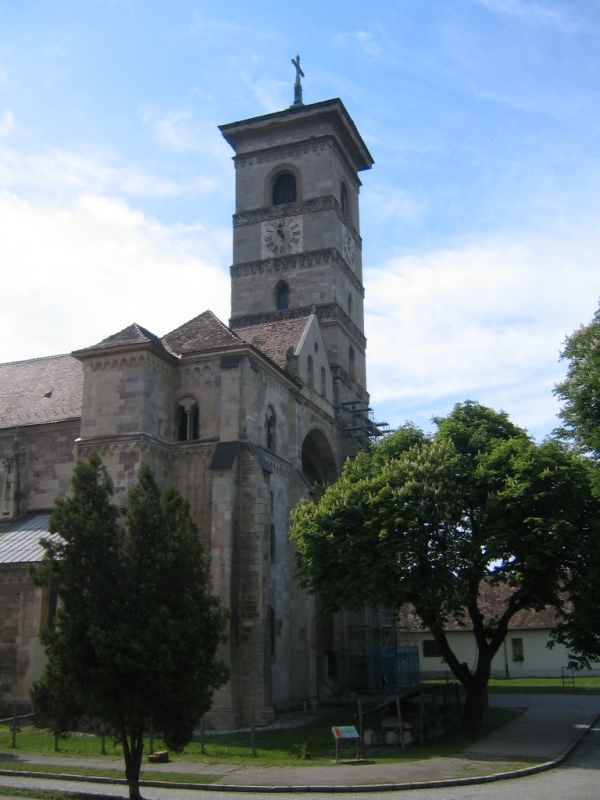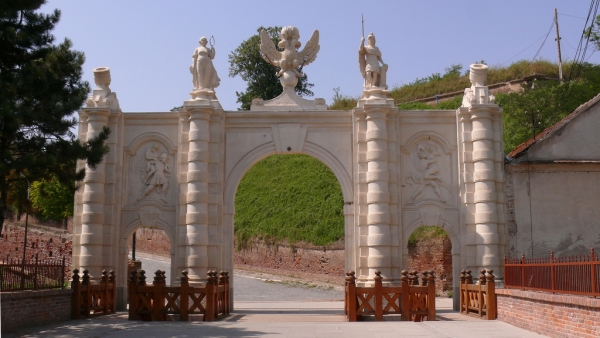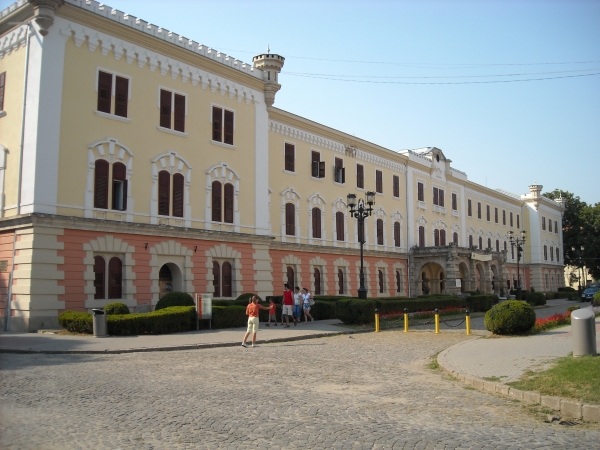The city
(Source: Wikipedia)
Alba Iulia is a city in Transylvania, Romania with a population of 66,747. Since the High Middle Ages, the city has been the seat of Transylvania's Roman Catholic diocese. Between 1541 and 1690 it was the capital of the Principality of Transylvania. Alba Iulia is historically important for Romanians, Hungarians and Transylvanian Saxons.
The history
(Source: Wikipedia)
The modern city is located near the site of the important Dacian political, economic and social centre of Apulon, mentioned by the ancient Greek geographer Ptolemy and believed by many archaeologists to be the Dacian fortifications on top of Piatra Craivii. After the southern part of Dacia became a province of the Roman Empire, the capital of the Dacia Apulensis district was established here, and the city was known as Apulum. Apulum was the largest city in Roman Dacia and the seat of the XIII Gemina Legion. Apulum is the largest castra located in Romania, occupying 37.5 ha (750 x 500 m2).>
In the 9th century, the name Belograd ("White Castle" in Slavic languages) is mentioned, a reference to the remains of white Roman walls. The Gesta Hungarorum mentions a Hungarian regent named Gyula (Jula, Geula), the maternal grandfather of Stephen I of Hungary and lord [regent] of Transylvania, who built the capital of his dukedom there during 10th century. Following the establishment of the Catholic Transylvanian bishopric after Stephen I of Hungary adopted Catholicism, the first cathedral was built in the 11th century or possibly even earlier, based on recent archeological discoveries. The present (Catholic) cathedral was built in the 12th or 13th century. In 1442, John Hunyadi, Voivod of Transylvania, used the citadel to make his preparations for a major battle against the Ottoman Turks. The cathedral was enlarged during his reign and he was entombed there after his death.

Alba Iulia became the capital of the Principality of Transylvania in 1541, a status it was to retain until 1690. The Treaty of Weissenburg was signed in the town in 1551. It was during the reign of Prince Gabor Bethlen that the city reached a high point in its cultural history, with the establishment of an academy. Further important milestones in the city's development include the creation of the Batthyanaeum Library in the 18th century and the arrival of the railway in the 19th century. Former Turkish equivalent was "Erdel Belgradi" ("Belgrade of Transylvania" in Turkish) where Erdel (Erdély) was added due to prevent from confusion such cities as Belgrat and Arnavut Belgradi ("Albanian Belgrade" in Turkish, early name of Berat during Ottoman rule).
In November 29, 1599, Michael the Brave, Voivode of Wallachia, entered Alba Iulia following his victory in the Battle of Selimbar and became Voivode of Transylvania. In 1600 he gained control of Moldavia, thereby uniting the principalities of Wallachia, Moldavia, and Transylvania under his rule. This lasted for a mere year and a half, until he was murdered in 1601, by general Giorgio Basta's agents.
At the end of WWI, representatives of the Romanian population of Transylvania (the exact number is disputed between Romanian and Hungarian historians) and representatives of the Transylvanian Saxons gathered in Alba Iulia, on 1 December 1918 (celebrated as the National Day in post-communist Romania), to proclaim the Union of Transylvania with the Kingdom of Romania. In 1922, Ferdinand of Romania Întregitorul was symbolically crowned King of Romania in Alba Iulia.
The landmarks
(Source: Wikipedia)
The main historical area of Alba Iulia is the Upper Town region, developed by Charles VI of the Holy Roman Empire in honour of whom the Habsburgs renamed the city Karlsburg. The fortress, with seven bastions in a stellar shape, was constructed between 1716 and 1735, by two fortification architects of Swiss origin. The first one was Giovanni Morandi Visconti, who constructed two old Italian stile bastions, followed by Nicolaus Doxat de Demoret, nicknamed "Austrian Vauban". The two architects radically transformed (after 1720) the medieval fortress shaped by the former Roman Castrum into a seven-bastion baroque fortress, developing Menno van Coehorn's new Dutch system, of which the fortress of Alba Iulia is the best preserved example.

Inside the fortress one may visit The Union Hall with the National Honour Galery, The National History Museum of Unification, the Princely Palace (Voivodal Palace), the Orthodox Cathedral, the Roman Catholic cathedral, the most representative building for the Medieval Romanic style in Transylvania), the Batthyaneum Library, the Roman Catholic bishop's palace, the Apor Palace, and the University of Alba Iulia.

Built in the 11th and 12th century (it was completed in 1009, and partially renovated under the communist regime), the Roman Catholic cathedral is considered to be an important monument of early Transylvanian medieval architecture. The tomb of John Hunyadi is located here, as is that of the Polish-born Isabella Jagiello, Queen of Hungary.
The Bathyaneum Library is a late church, built in Baroque style. In 1780, Ignác Batthyány, bishop of Transylvania, adapted the inside of the establishment for its present use as a library. It is famous all over the world for its ample series of manuscripts, incunabula and rare books, such as Codex Aureus (9th century), also known as the Lorsch Gospel, containing the Gospel of Mark and Matthew, David's Psalms, Codex Burgundus (15th century), Biblia Sacra (13th century), the Pentateuch from Orastie (1850), Serban Cantacuzino's Bible, and the New Testament from Balgrad (1648). The first astronomical observatory in Transylvania was founded here in 1792.
The Orthodox Unification Cathedral was built between 1921 and 1923, following the plans of arch. D.G. Stefanescu, and built under the supervision of eng. T. Eremia. The frescoes were painted by Constantin, in a traditional iconographic style. The first monarchs of the Unified Romania, King Ferdinand I and Queen Marie, were crowned in the cathedral, on 15 October 1922.
The National Museum of Unification in Alba Iulia is located in the "Babylon" Building. It was originally built for military purposes (1851–1853) and transformed into a museum since 1887. The museum exhibits over 130,000 pieces of priceless works, organized chronologically: first a Pre-history Section, then Dacian and Roman Period, the Feudal section, followed by the great battles with the Turks, the Liberal Revolution of 1848, the Unification of the Principalities of Moldavia and Wallachia in 1859, the World War I, the Union of Transylvania with Romania, and so forth. In its two floors with more than a hundred rooms are housed the basic exhibition, the warehouse, the library, and the restoration laboratories. The Unification Hall, also part of this national history museum, retains historical significance from having hosted, on 1 December 1918, the rally of the 1228 Romanian delegations from all Transylvania, who determined the province's union with the Kingdom of Romania. The building was used in 1895, as a military Casino.

The Apor Palace is situated on the same street as the Bathyaneum Library. It belonged to Prince Apor, and was built in the second half of the 17th century. At the beginning of the 18th century it was the residence of the Austrian army leader, at the time Prince Steinville. The palace was renovated in 2007 under the supervision of the Romanian Ministry of Culture.
The Princely Palace (Palatul Principilor or Palatul Voievodal) was Michael the Brave's residence during the first political unification of the Romanians in 1600. Foreign chronicles pictured it as an extremely luxurious building, richly adorned with frescos and marble stairs, later deteriorated. During the rule of Princes Gábor Bethlen and George II Rákóczi the second palace was restored, but not to its previous condition. After 1716, the building was used as an Habsburg Imperial Army barracks.